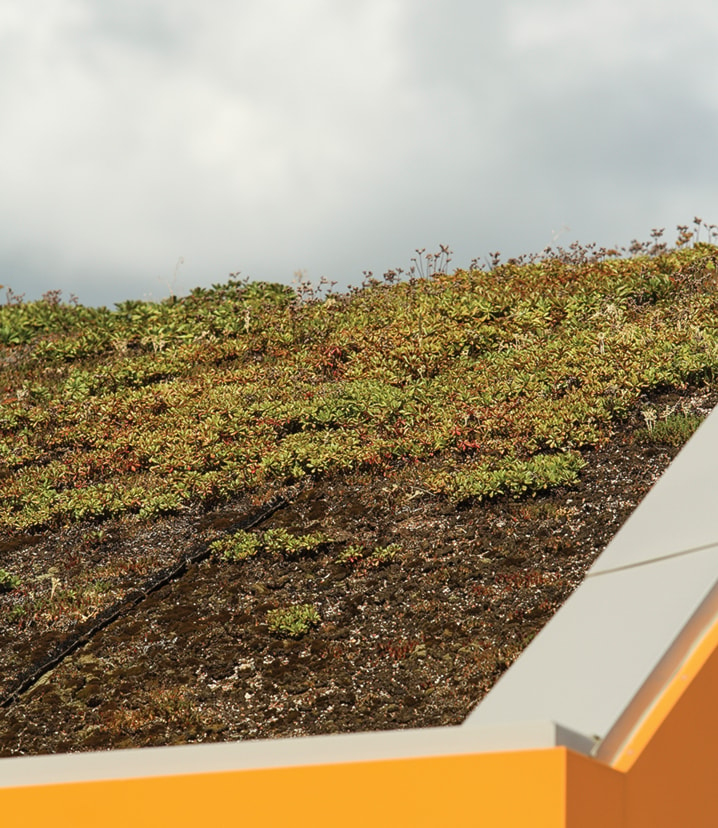A living roof in downtown Red Deer has been allowed to go brown because of a planning oversight.
Almost four years have passed since city officials cut the ribbon to open the Sorensen Station transit terminal and parkade, crowned with a roof of sedum that designers promoted as a means of reducing the runoff and unwanted solar heating that are typically associated with large buildings.
It turns out that the green roof over Sorensen Station does not need a lot of maintenance, but it does need a little — and that can’t happen right now because there is no fall protection for the people performing those tasks, said parking co-ordinator Fried Dieno.
The sedum has died back, leaving a smattering of foxtail and other weeds in its place.
“The plants that are up there are dormant right now,” Dieno said on Thursday.
“If you noticed in spring, they were green and different colours. But they do go dormant. They are highly drought resistant. But they do have to be weeded twice a year and fertilized twice a year, and that hasn’t happened.”
Workers from the Montreal-based company that installed the roof performed those duties under warranty for the first three years, said Dieno. However, regular maintenance is now the city’s job and city workers cannot go onto the roof until fall protection has been installed.
“We dropped the ball on that one,” said Dieno. The city had to shop around to find a portable system that would do the job without becoming an eyesore.
A system has been found and will be installed as soon as contract details are worked out. But there will be no care for the plants until that system is in place.
“It’s going to take a year or two to bring (the sedum) back. It’s gotten quite weedy.”
Dieno said he has learned since the construction of Sorensen Station that barrel-shaped roofs can have problems, largely as a consequence of being buffeted by wind.
“It’s something we did learn the hard way. I’m not sure if it’s never going to be perfect.”
Dieno said he sees the roof from his window every time he stands up in his office at City Hall.
“It just really irritates me that we can’t do something about that sooner,” he said.
Red Deer architect George Berry said he is aware of the problem at Sorensen Station, which is visible from the green roof his company built on its office on Gaetz Avenue, immediately south of the Saputo plant. Customers of his have commented on the Sorensen Station roof while meeting with him on the roof of the Berry Architects building.
His company’s living roof was more costly to install than a regular roof, but worth every penny on a variety of fronts, said Berry. Part of the incentive was to address environmental concerns associated with the building, he said. The living roof cuts down significantly on unwanted solar heating, provides insulation to the building below and collects excess water that is used to flush the toilets.
The roof includes native grasses, a vegetable garden, a 2,000-square-foot patio suitable for meetings and parties, a small stream and a canoe. Maintenance was definitely a factor to be considered, but the amount of work required has declined over time and is definitely down from last year, when the first plants were started.
Berry said a similar but less extensive project has also been installed at Catholic Social Services, two blocks north of City Hall.
Likely the oldest green roof in Red Deer is the small lawn growing on the Norwegian Laft Hus, built in 1987 on a spot near the Recreation Centre and the Museum and Art Gallery.
Laft Hus Society members Stan and Betty Wulff said the sod was placed on the roof to mimic the style of a Norwegian farmhouse, which would typically include a wooden ramp for goats to go up and graze.
The Laft Hus roof was installed over an impermeable layer of specialized plastic, with a layer of birch bark around the edges to look more authentic. The sod was installed in two layers, laid root to root, in part to increase its stability.
An irrigation system was also placed on the roof to keep it watered as necessary, and it has been mowed from time to time, said Stan Wulff.
Sorensen Station cost just over $21 million to build and was opened officially on Aug. 28, 2010. The roof is not accessible to the public.
bkossowan@www.reddeeradvocate.com
